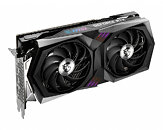- Joined
- Oct 9, 2007
- Messages
- 47,670 (7.43/day)
- Location
- Dublin, Ireland
| System Name | RBMK-1000 |
|---|---|
| Processor | AMD Ryzen 7 5700G |
| Motherboard | Gigabyte B550 AORUS Elite V2 |
| Cooling | DeepCool Gammax L240 V2 |
| Memory | 2x 16GB DDR4-3200 |
| Video Card(s) | Galax RTX 4070 Ti EX |
| Storage | Samsung 990 1TB |
| Display(s) | BenQ 1440p 60 Hz 27-inch |
| Case | Corsair Carbide 100R |
| Audio Device(s) | ASUS SupremeFX S1220A |
| Power Supply | Cooler Master MWE Gold 650W |
| Mouse | ASUS ROG Strix Impact |
| Keyboard | Gamdias Hermes E2 |
| Software | Windows 11 Pro |
It looks like NVIDIA is finally taking AMD's route in the mid-range by giving the third-largest silicon in its next-generation GeForce "Ada" RTX 40-series a narrower PCI-Express host interface. The AD106 silicon will be NVIDIA's third largest client GPU based on the "Ada" architecture, and succeeds the GA106 powering the likes of the GeForce RTX 3060. This chip reportedly features a narrower PCI-Express x8 host interface. At this point we don't know if the AD106 comes with PCI-Express Gen 5 or Gen 4. Regardless, having a PCIe lane count of 8 could possibly impact performance of the GPU on systems with PCI-Express Gen 3, such as 10th Gen Intel "Comet Lake," or even AMD's Ryzen 7 5700G APU.
Interestingly, the same leak also claims that the AD107, the fourth largest silicon powering lower mid-range SKUs, and which succeeds the GA107, features the same PCIe lane-count of x8. This is unlike AMD, which gives the "Navi 24" silicon a PCI-Express 4.0 x4 interface. Lowering the PCIe lane count simplifies PCB design, since there are fewer PCIe lanes to be wired out in precise trace-lengths to avoid asynchrony. It also reduces the pin-count of the GPU package. NVIDIA's calculation here is that there are now at least two generations of Intel and AMD platforms with PCIe Gen 4 or later (Intel "Rocket Lake" and "Alder Lake," AMD "Zen 2," and "Zen 3,") and so it makes sense to lower the PCIe lane-count.

View at TechPowerUp Main Site | Source
Interestingly, the same leak also claims that the AD107, the fourth largest silicon powering lower mid-range SKUs, and which succeeds the GA107, features the same PCIe lane-count of x8. This is unlike AMD, which gives the "Navi 24" silicon a PCI-Express 4.0 x4 interface. Lowering the PCIe lane count simplifies PCB design, since there are fewer PCIe lanes to be wired out in precise trace-lengths to avoid asynchrony. It also reduces the pin-count of the GPU package. NVIDIA's calculation here is that there are now at least two generations of Intel and AMD platforms with PCIe Gen 4 or later (Intel "Rocket Lake" and "Alder Lake," AMD "Zen 2," and "Zen 3,") and so it makes sense to lower the PCIe lane-count.

View at TechPowerUp Main Site | Source






 ) for a GPU upgrade are still PCI-e 3.
) for a GPU upgrade are still PCI-e 3.